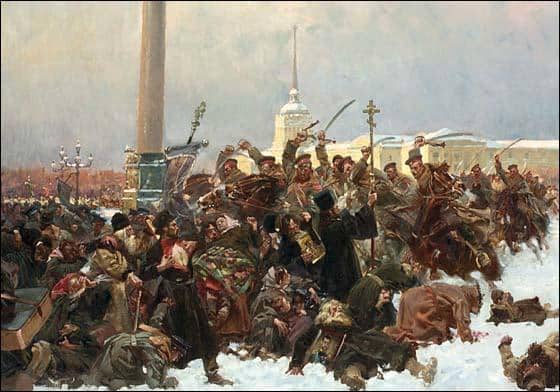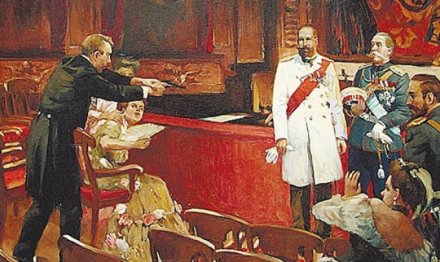It is possible to argue that the Tsarist regime was strong in 1914 because of the introduction of reforms under both Alexander III and Nicholas II. Economically too, there was significant growth and development.
On the other hand, some historians have argued that the Tsarist regime was already doomed by 1914 as this development came at the cost of the quality of life of a majority of the working class, and was also made null by the spiking levels of suppression used by main figures with the leadership.

Strikes and revolutions set the stage for most of the Tsarist regime leading up to 1914. The most significant of these was the 1905 revolution during the reign of King Nicholas II.
As a result of a multitude of political, economic, and social shortfalls of the time, strikes spread across the country, and illegal trade unions were widespread. One of the major reasons for this revolution was economic discontent amongst Russian peasants.
Despite an exponential growth of the economy under Minister Sergei Witte, the resultant disproportionate increase in population led to far more poverty and a far lower quality of life than ever before.
Furthermore, as a combined result of literacy spreading, and peasants being targeted by a multitude of revolutionary groups, civil unrest became commonplace – with the appearance of the first workers’ strike committees called the soviets in 1896. Laws brought in under Alexander III and Nicholas II protecting workers had little to no effect as the working day still remained 11.5 hours long.
The economic downturn in the early 1900s did nothing to quell the already disillusioned and disgruntled peasantry. Furthermore, Russia’s unprecedented and humiliating defeat by Japan in the Russo-Japanese war of 1904-05 brought even more critical attention to the Tsarist regime.
Dissent caused by a number of smaller strikes over the last decade built up and was sparked by this defeat, causing the 1905 revolution. The most immediate reason for the 1905 revolution, however, was the Bloody Sunday massacre that took place in January. Opening fire on the crowd that had peacefully gathered to demonstrate against the Tsar, Russian soldiers killed over 200 civilians, injuring multitudes more.
The Tsar actively supported terrorist groups like the Black Hundreds and empowered the Okhrana to control all opposition to the Tsar, by arresting and murdering Bolsheviks and Mensheviks, which ultimately lead to the 10-year long exile of Lenin. By 1910, rigged trials and unfair executions had reduced the number of revolutionaries from 100,000 to 10,000. These revolutions also led to the Tsar offering reformations in a final bid to hold on to an already weak Tsarist regime.
The creation of the Duma, Stolypin coming into power, and the October Manifesto being released – while being slightly tokenist measures – did help strengthen the Tsarist regime to a certain extent as will be discussed in the following paragraphs. Overall, these continuous strikes and calls for the overthrow of the Tsar were extremely detrimental to the strength of the Tsarist regime in 1914, despite the Tsar’s taking measures to quell them in the short term.
The October Manifesto and the introduction of the Duma had led to a more democratic government. Sergei Witte was a driving force of political reformation during Nicholas II’s reign – bringing about unprecedented levels of change to the Russian system of governance. In 1905, he persuaded the Tsar to pass the October Manifesto, one that promised significant political reform, and significant improvements to governance – if wielded right.
Formed with the aim of giving people more rights and therefore garnering their support for Tsarism and the Tsar, the Manifesto promised three main things – a Duma (elected national parliament) that had ultimate legislative control, the loosening of censorship, and increased rights for people to gather for discussions and meetings.
Four dumas were held between 1906 and 1917 – the first two featuring strong opposition to the Tsar, and the next two being more flexible and less radical as a result of revised voting systems. The first duma, established in May of 1906 under Witte’s successor as Minister of Finance – Stolypin – was comprised mostly of Kadets (rich peasants) and Social Revolutionaries (SRs), which led for it to demand further political reform such as land reform and the release of political prisoners.
Despite these calls for change, it was allowed to continue to function – until it passed a no-confidence motion against then Prime Minister Ivan Goremykin where it was then dissolved. Since the duma was only established to give the peasants an illusion of control, the second duma had much the same fate for much the same reasons as the first – and the moderate left despised Stolypin and the ideologies he represented for dissolving the first two attempts at representational government.
The third duma, established in 1907 was intended to be far more conducive to the Tsar’s aims and therefore supportive of his actions. This was made possible by the landowners being given more voting power and therefore more sway within the government, making it far less radical than the previous two. It was dissolved in 1912, and the fourth duma established in November of 1912. However, conflicts caused by the opposing views of the Octoberists and the Socialists made it impossible to unite the duma to achieve anything particularly substantial and therefore was dissolved in 1915.
The reactions to the October manifesto were varied – the liberals were content with it, the Kadets wanted more freedom and rights granted to peasants, and the SRs, including the Mensheviks and Bolsheviks, were critical of it. The October Manifesto, therefore, succeeded not in its original aim of pacifying the peasantry but instead strengthened the Tsarist regime in far more substantial ways – by dividing the opposition.

Stolypin’s reforms were aimed at modernizing Russia to make it more competitive with foreign countries, but most importantly, were introduced in the hopes that reorganizing the distribution of land would pacify the peasantry and allow for the Tsar’s smooth reign.
To this end, he abolished the redemption payments that had plagued Russian peasants for generations and gave them financial incentives to move to remoter areas of Siberia in order to open up urban areas.
These reforms – especially the agrarian ones were extremely successful in that agricultural input increased by a third, but more importantly, because the resultant 30% increase in peasant land ownership birthed a new slew of Kadets who owed their economic rise to the Tsar and his reforms, and therefore were loyal to him.
Despite new measures taken to ensure more safety and satisfaction of working peasants such as the formation of trade unions being made legal in 1905, and safety inspectors being introduced to factories, there was still a great deal of discontent amongst workers as frequent strikes like the Lena gold mine strikes were still taking place.
A situation similar to Bloody Sunday arose again – hundreds of protestors were wounded and killed by an increasingly violent army in an effort to stop protestations. Stolypin’s attitude towards suppression was so extreme that the hangman’s noose was nicknamed “Stolypin’s necktie” – such was his synonymity with oppression and violence.
Despite Stolypin’s aims being derevolutionising the peasant class, his policies and reforms hardly came to fruition as what was supposed to be a 20-year program was cut down to five when Stolypin was assassinated in 1911. His assassination reflects the unpopularity of the way in which he went about his reforms – his policy being suppression first and then.
Since he was an extension of the Tsarist regime, it also reflects the discontent towards Tsar, thereby weakening the position of the Tsardom within Russian society.
Rasputin’s influence on Tsar Nicholas II and his family had a significant impact on the strength of the Tsarist regime in 1914. Believed to be the only one who could cure Nicholas’s son Alexis and ensure his succession to the throne, Rasputin – a lowly born, lecherous drunkard – was able to influence Russian politics via the Tsar and had more power than any single man besides the Tsar had.
Not only were his public displays of indecency a stain on the Tsar’s reputation, his misguided and often self-interested views on political affairs led to him being despised amongst both the nobility and the peasants. The wild rumors about the level of influence he had and his relationship especially with the Tsarina provided revolutionaries with added power to undermine the Tsarist regime.
Furthermore, his influence on the Tsar’s political appointees caused riffs even between Stolypin – the Tsar’s most powerful and effective minister – and the Tsar. Rasputin had no positive influence on the Tsar and only served to undermine the authority and credibility of the Tsar in the eyes of both the nobility and the peasants.
Overall, the Tsarist regime was extremely weak in 1914 due to a combination of civil unrest, unpopular reforms, and increased suppression, and was doomed to fail even before major factors such as the 1905 revolution and Rasputin’s ascent to power.
